Alan Cathcart | January 25, 2019
Triumph is looking to reclaim its place as the king of modern scrambling with two all new models in the Scrambler 1200 XC and XE. We sent Alan to Portugal to sample the goods.
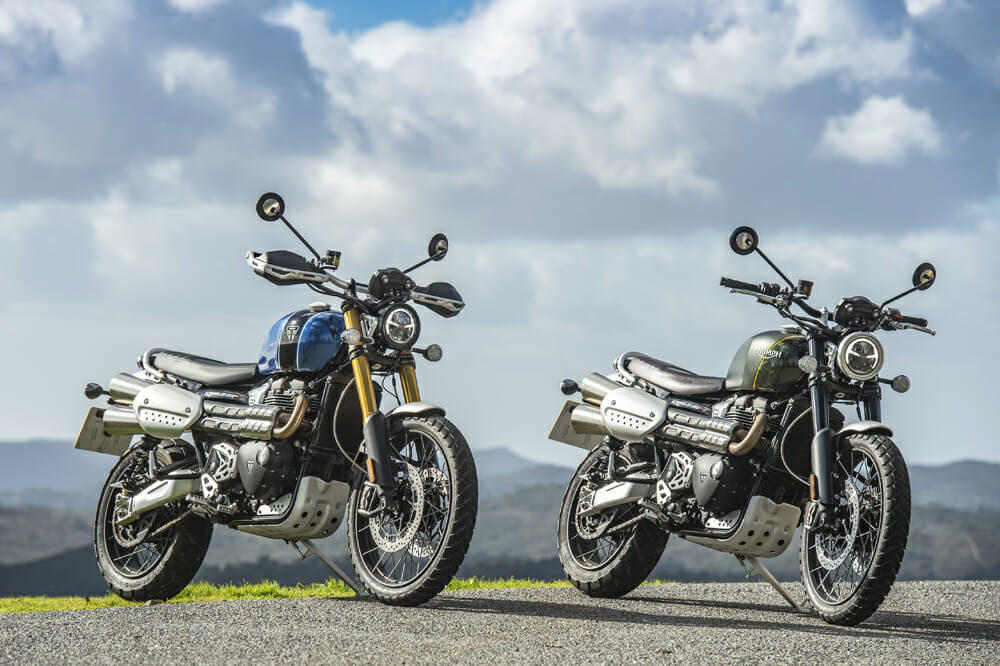 The XE (left) and XE represent a new direction for Triumph’s scrambler range, and have nearly every base covered for road or off-road scrambling.
The XE (left) and XE represent a new direction for Triumph’s scrambler range, and have nearly every base covered for road or off-road scrambling.
Crossover automobiles are becoming ever more popular, as passenger car platforms are increasingly used to create a multi-purpose vehicle with the space and practicality of an SUV, but the comfort and handling of a saloon.
The same thing is true with bikes—the most obvious example being BMW’s succession of best-selling GS models, or Honda’s NC750X and CB500X, and especially the VFR1200X Crosstourer, all attempting to deliver the best of both worlds without one compromising the other.
But now Triumph has delivered a pair of crossover models which seek to answer a different question—how to combine retro cool with modern functionality, in a dual-purpose motorcycle. That’s the conundrum which faced Triumph’s chief engineer Stuart Wood and his R&D team three-and-a-half years ago when they began work on creating the new for 2019 Scrambler 1200 duo, in both XC and XE variants. To do so, they took the all-new 1198cc liquid-cooled parallel-twin T120 engine they’d just launched to power the new generation of larger capacity Bonneville models, headed by the Thruxton café racer.
For rather than concocting a power up version of the 900cc Street Scrambler, which just as it says on the label has only minimal off-road pretensions, Wood & Co.’s design brief was to develop a pair of crossover bikes with the Bonneville family’s traditional twin-shock neo-classic styling, which were just as adept both on and off-road as the company’s thoroughly modern 800XR/XC dual purpose triples. In this way, Triumph is seeking to restate the genuinely polyvalent nature of the Scrambler nametag, which it first laid claim to 13 years ago, long before BMW or Ducati ever used the name today on what amount to street custom models.
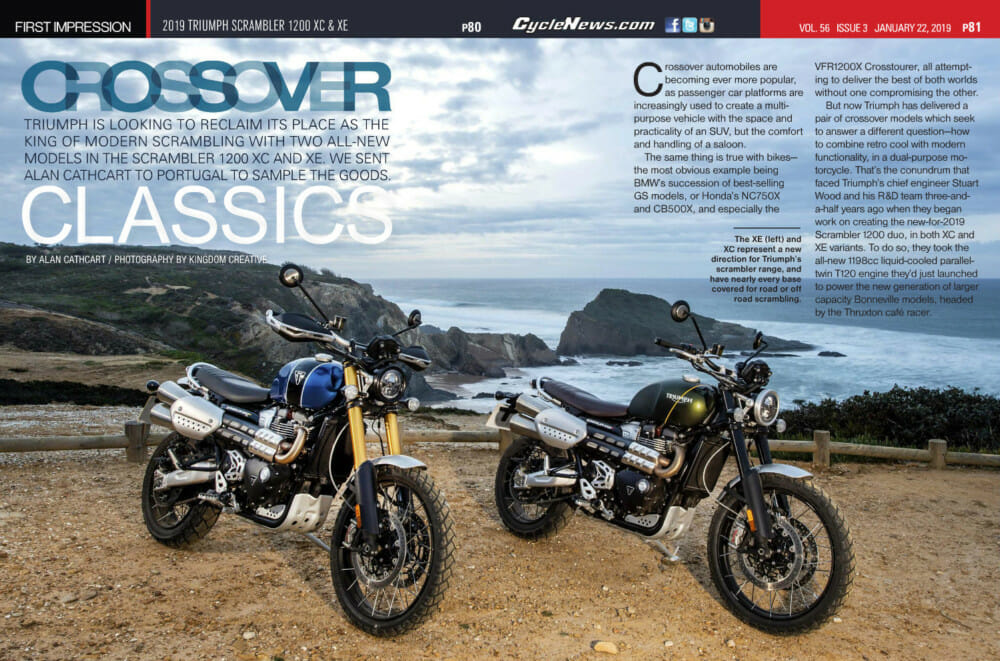
Photography by Kingdom Creative
2019 Triumph Scrambler 1200 XC and XE Riding Review
The chance to evaluate how well Wood’s team has succeeded in doing this came on a two-day press launch in southern Portugal, with day one devoted to off-road riding along trails made muddy after a day-long deluge, and day two in eventual bright sunshine after a morning of further rain along the fabulous sweeping, swooping mountain roads behind the Algarve region’s tourist-heavy coastline.
The XC that’s available in dealerships in late January is the everyday tarmac-friendly version of the two, costing $14,000 with the more off-road-focused XE (as in, E for Extreme) retailing at $15,400. Both bikes are powered by the same liquid-cooled parallel-twin eight-valve 1198cc Bonneville engine.
But rather than detune performance of these dual-purpose models to the level of the T120 Bonneville by using this engine in the T120’s HT/High Torque guise, Wood decided to employ the more powerful HP/High Power variant fitted to the Thruxton—and then enhance it considerably for dual-purpose use.
Both Scrambler 1200 models feature a long service interval of 10,000 miles.
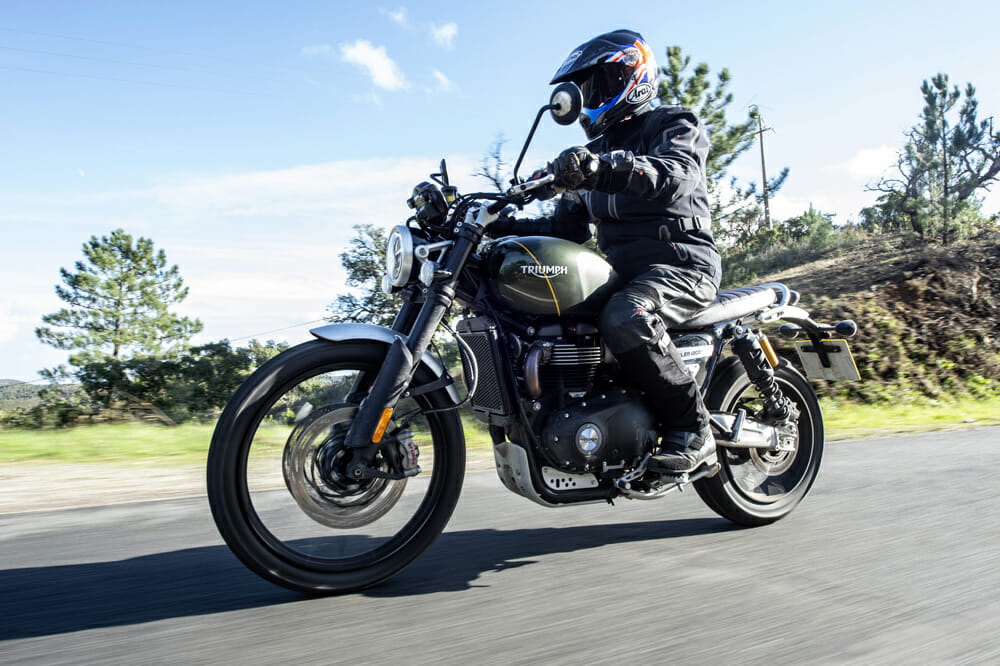 Perfectly upright, a delightful engine and good suspension—the XC will make a perfect back roads companion.
Perfectly upright, a delightful engine and good suspension—the XC will make a perfect back roads companion.
Inside the 2019 Triumph Scrambler 1200 XC & XE Engine
The HP Bonneville 1200 engine delivers 88.7 horsepower at 7400 rpm, which is 12.5-percent more power than the Bonneville T120 and 38 percent more than the 900cc Street Scrambler, albeit 7-percent less powerful than the 96-horsepower Thruxton.
But Wood & Co. have delivered the best of both worlds by massaging the engine’s torque delivery to peak at 81 lb-ft at a low 3950 rpm, less than halfway to the rev-limiter. That’s just 1.4 lb-ft less than the Thruxton, but with a much wider spread of grunt throughout the rev range, and it’s also 4-percent more than the T120 Bonneville’s supposed High Torque engine delivers, and 37.5-percent greater than the smaller-capacity Street Scrambler. This output comes with the aid of the beautifully crafted twin high-level exhausts, with stainless-steel headers and brushed stainless-steel silencers, which delivers what Triumph describes as “a deep punchy scrambler sound.” Personally, I thought it sounded great in delivering the best of both worlds, with more of what you need when you need it than any other 1200 Bonneville variant.
Just as on all the new-generation Bonnevilles, the Scrambler 1200 duo’s Keihin ECU features an RBW/ride-by-wire throttle with a choice of five riding modes (Road, Rain, Off-Road, Sport and a rider-configurable Custom setting) all of which deliver the same peak power. There is also a five-stage TC/traction-control setting.
The Scrambler 1200 XE also features an Off-Road Pro mode, which switches off ABS and TC altogether, and offers a dirt-friendly throttle map. Switching modes on the move is a simple business—just close the throttle, press the M-button on the left ’bar, then pull in the clutch to confirm the swap. Worth noting you must also hold in the clutch lever to start the Scramblers, even in neutral, though the clutch action is extremely light, denoting the presence of Triumph’s so-called “slip assist” design.
That’s their version of a slipper clutch, though with more engine braking left in than is usual with one of those, which means that on winding country roads where you can hold third gear for miles on end, you only rarely do more than caress the front-brake lever occasionally to slow for a tighter turn.
Just concentrate on swinging from one side to another through a series of turns, and the inherent engine braking will slow you just sufficiently to keep up turn speed to the desired degree. The same six-speed gearbox fitted to the T120/Thruxton is retained here with unchanged ratios, with an impeccable gearshift. So light and smooth, yet precise, it’s undoubtedly Triumph’s best yet, and is literally beyond criticism, with clutchless upward changes a matter of course for all except from first to second, where you must use the clutch to help negotiate neutral.
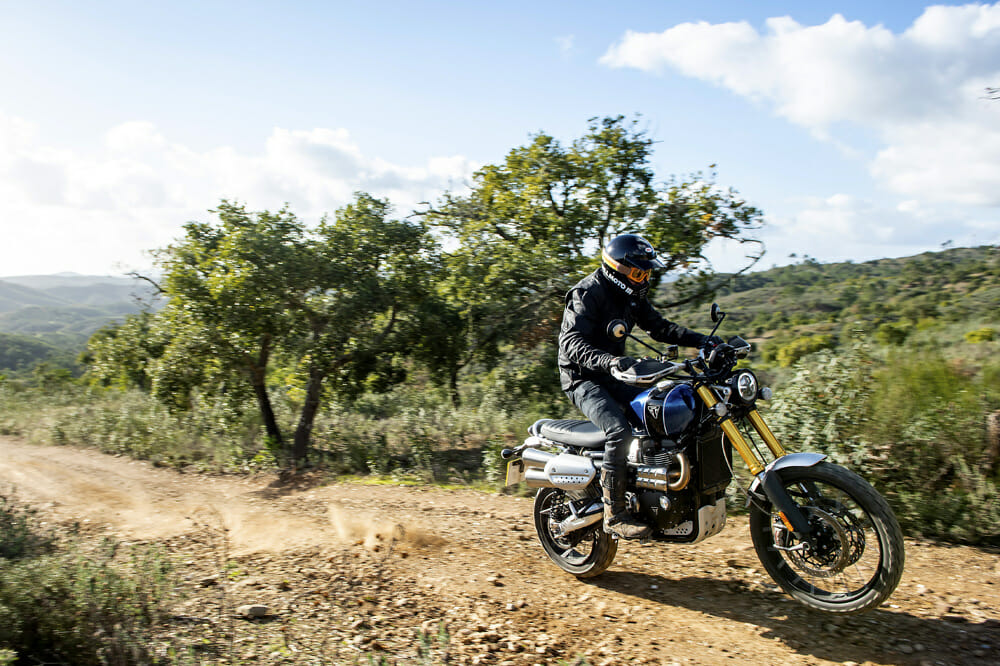 Off-road handling for the XE is spectacular.
Off-road handling for the XE is spectacular.
The 2019 Triumph Scrambler 1200 XC & XE engine has torque for days.
What all that earlier number crunching means is that the engine powering this new pair of Scrambler 1200 models is more than adequately potent, while also meaty in its delivery thanks to that wide spread of torque from very low revs. It pulls cleanly away in top gear from as low as 1800 rpm without a trace of transmission snatch, with that early peak torque being maintained all the way to the soft 7500 rpm rev-limiter. It’s an invigorating and involving motorcycle to ride, mainly thanks to the lighter crankshaft and other internals, it’s eager to build revs without being snatchy off the mark, yet remains a relaxing easy rider if you choose to hold a gear, and surf the torque curve.
The first touch of throttle is smooth and controllable in all riding modes. The Sport-riding mode has a crisp but controllable throttle response, and its fuel mapping is that word again: impeccable. Both Scramblers are responsive without being fierce or snatchy, even from a closed throttle, and in spite of the lightened crank, I ended up using third gear much the time, even in traffic—everywhere except on longer straight stretches.
There, 4000 rpm in top gear equals 80 mph, which makes a nice cruising speed for this high-barred motorcycle—go much faster than that, and you’ll have to hold on so increasingly tightly that it becomes tiring, though for those who insist on doing so, this is very much a ton-up trailie. But third gear will take you from 25 mph at 2000 revs all the way to 75 mph at 7000 rpm where it’s best to change up as you feel the engine start to get a little breathless—strange, since peak power still hasn’t been attained—so holding this for miles on end, even through towns and villages, makes this a semi-automatic motorcycle whose broad spread of torque is especially useful off-road.
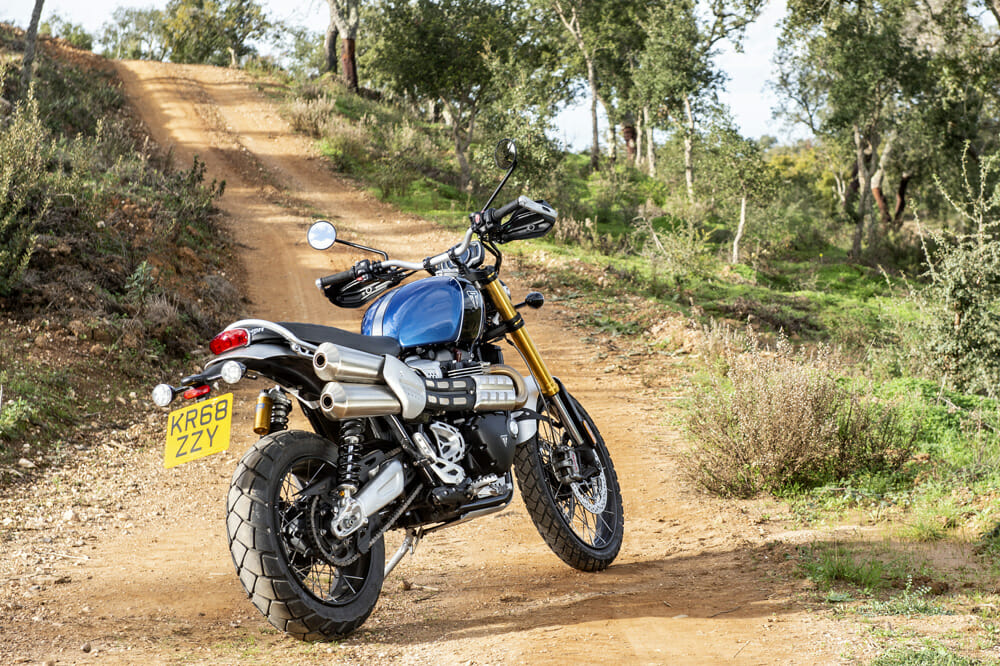 Ohlins handles off-road duties on the XE and are well up to the task.
Ohlins handles off-road duties on the XE and are well up to the task.
The Chassis of the 2019 Triumph Scrambler 1200 XC & XE
The spin off spec from the Thruxton is confined to the engine, because the modular format chassis used by the Scrambler 1200 duo are brand-new, with a tubular steel duplex cradle frame mated to aluminum engine plates. But each version has a subtly different geometry, with a shorter 60.2 in. wheelbase for the tarmac-focused XC, which also sees its fully adjustable 45mm Showa USD fork set at a 25.8° rake with 4.7 inches of trail in delivering an already off-road-friendly 7.87 inches of wheel travel.
But the dirt-focused XE is even more Extreme, with a 61.8 inch wheelbase and fatter 47mm USD Showa fork set at a 26.9° rake with a hefty 5.08 inch trail in pursuit of greater stability off road. Both versions feature twin-shock rear suspension courtesy of Öhlins, with the XE delivering a massive 9.84 in. rear wheel travel thanks to the specially-developed ultra-long 20.4 in. laydown rear shocks from the Swedish suspension sultans Ohlins, each with dual coil-over variable-rate springs whose overall format is a further look in that rear-view mirror of yesteryear.
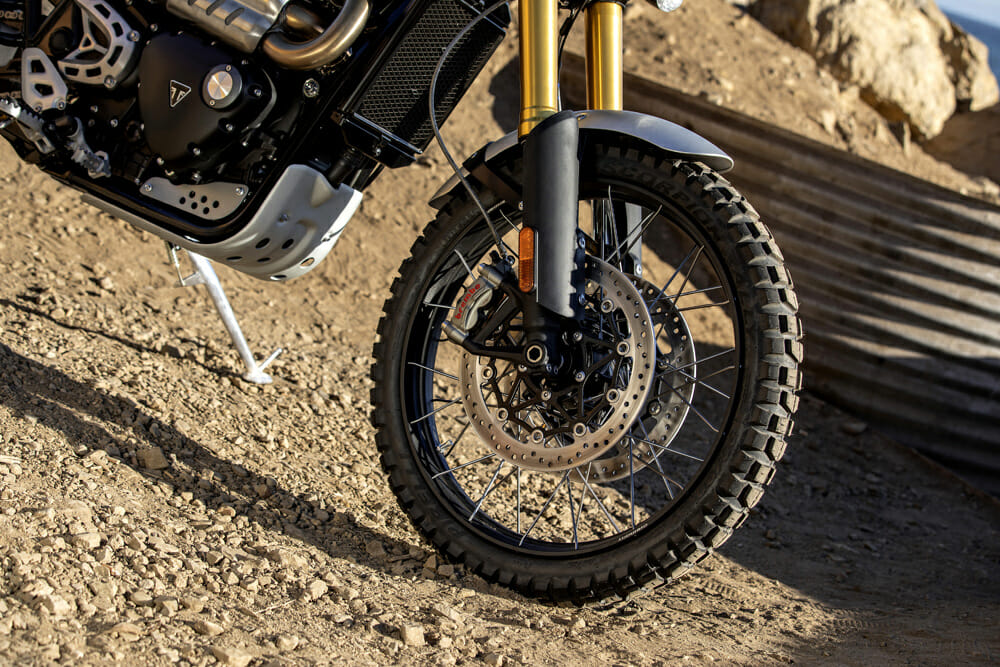 Extra-long travel suspension for the XE means it’ll go places even proper adventure bikes won’t.
Extra-long travel suspension for the XE means it’ll go places even proper adventure bikes won’t.
The XE’s slightly longer wheelbase comes mainly courtesy of a longer twin-sided anodized aluminum swingarm that’s 22.7 inches in length, compared to the XC’s 21.5-inch long item. This throws more weight onto the front wheel in pursuit of extra grip, and the fact that this is a 21-inch item on both bikes (matched to a 17-inch rear) denotes the seriousness of their focus on off-road use. The XC comes fitted with Metzeler Tourance tires, while knobby Pirelli Scorpion Rally off-road friendly rubber adorns the XE. Both bikes feature wire wheels carrying side-laced Akront alloy rims, which permit tubeless tires to be fitted. Perhaps surprisingly, given the off-road focus of both models, their brake package is totally sportbike-derived, with twin 320mm front discs gripped via a radial master cylinder by Brembo’s benchmark M50 monoblock radially mounted calipers.
There’s a single 255mm floating rear disc with twin-piston caliper, and you do need to take care riding either bike off-road in Off-Road Pro mode not to use those hefty front brakes even remotely hard, else you will, ahem, hit the dirt after you’ve locked the front wheel with the ABS switched off—or in my case go for a deep immersion mud bath!
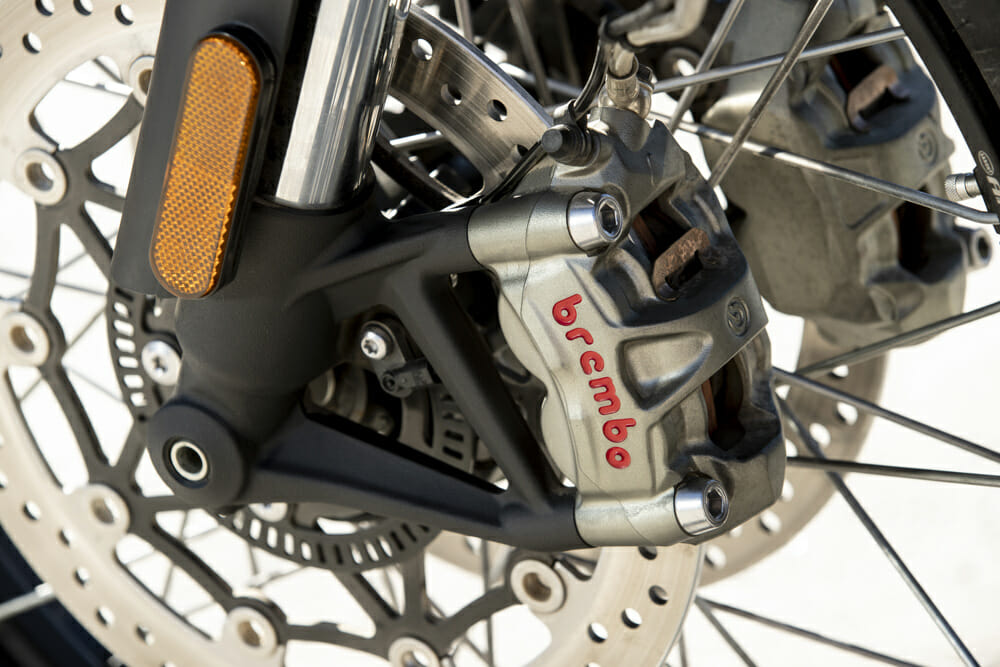 Superbike stoppers for a scrambler? Yes, please!
Superbike stoppers for a scrambler? Yes, please!
Test Riding the 2019 Triumph Scrambler 1200 XC & XE
Standing on the footpegs you’re aware of the heat coming off the exhausts on the right, and this could well be a complaint in warmer conditions than a winter’s day in Portugal. The wide reversible and adjustable handlebar that’s 65mm wider on the XE gives good leverage, but thankfully it can be rotated if you’re going to stand up on the footpegs, otherwise the clutch/brake lever are uncomfortable to operate.
The updated TFT dash has an option of two different displays, and features a more advanced version of the same five-way joystick-operated system on the Tiger 800, Tiger 1200, Speed and Street Triples. Three-stage heated grips are standard on the XE as is keyless ignition, a USB charger, single-button cruise control, and an IMU/Inertial Measurement Unit permitting Cornering ABS (on the XE only) and five-stage Traction Control. And in what Triumph claims to be a world first, both Scrambler 1200’s feature an integrated GoPro control system, facilitating GoPro camera operation via connectivity from an optional Bluetooth module. The connection and control are displayed on the TFT dash, enabling intuitive video and photo operation via the switchgear once the optional Bluetooth connectivity module is fitted, and the camera can be accessed and controlled via the TFT display and joystick. The same goes for the optional integrated Google-operated turn-by-turn sat-nav-integrated navigation system, again facilitated through an accessory fitted Bluetooth module. There’s a range of over 80 dedicated Scrambler 1200 accessories available and two Inspiration Kits: a touring-based Escape and a stripped-down Extreme model.
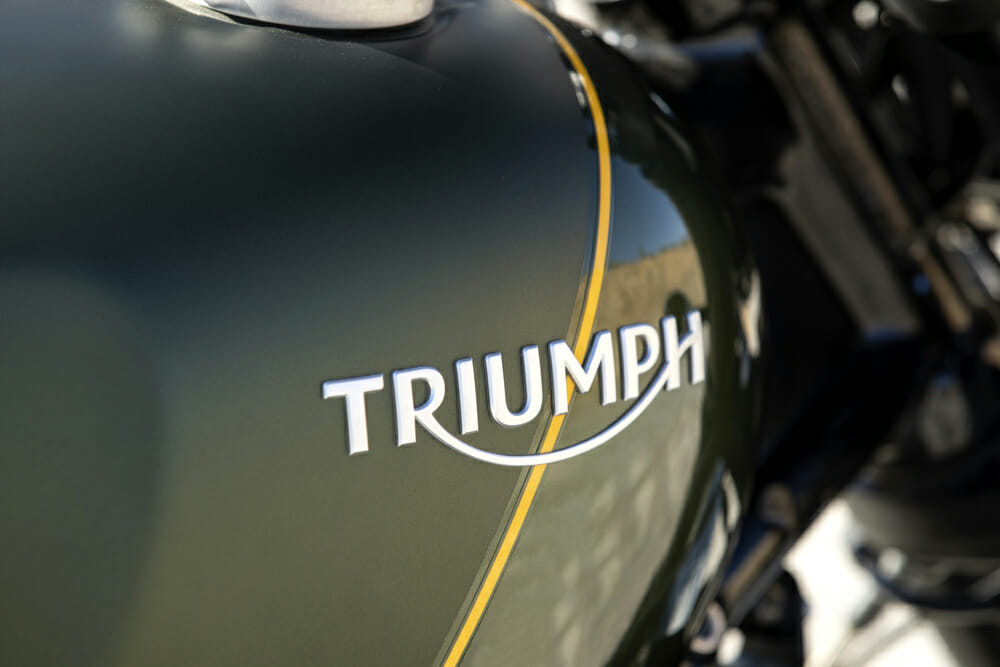 Fit and finish is brilliant with the new scramblers.
Fit and finish is brilliant with the new scramblers.
The 4.2-gallon seamless fuel tank that’s scalloped out up front to give clearance for the fork legs at full lock, and gives a range of about 150 miles, based on Triumph’s claimed fuel consumption of 46 mpg. Dry weight is 451 pounds (XC) or 456 pounds (XE) dry weight. Seat height is a tall 33.1 inches on the XC and an even rangier 34.4 inches on the XE, but while it looks rather plank-like in appearance, the retro-looking seat proved pretty comfy after spending time actually sitting on it when we went traipsing on tarmac, as opposed to standing on the pegs off-road.
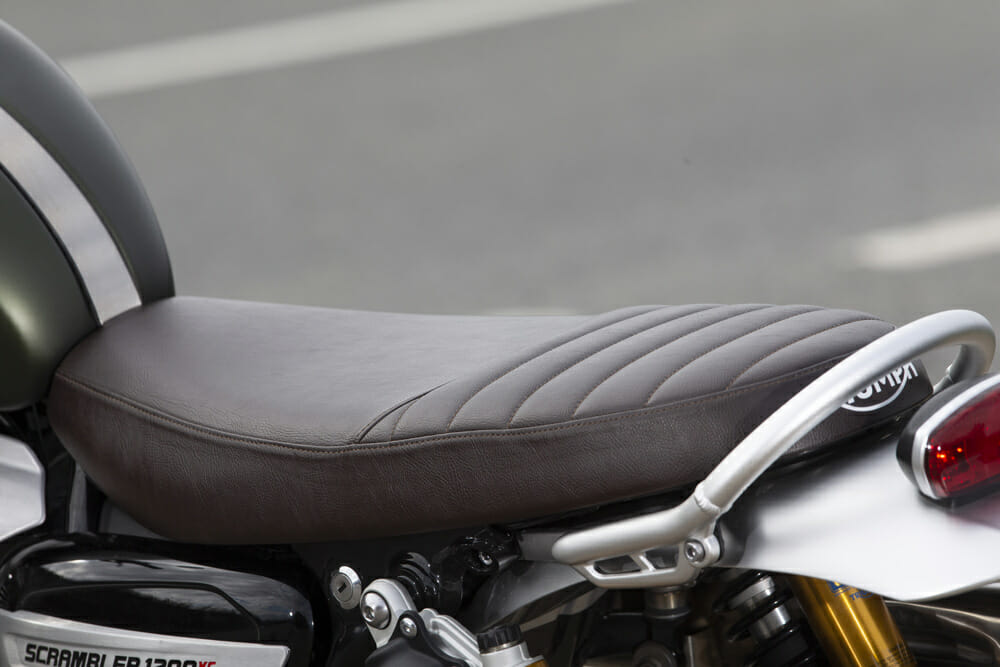 The XC seat is good for an hour or so but can feel a bit hard after that.
The XC seat is good for an hour or so but can feel a bit hard after that.
However, I did get some numb-bum syndrome after a 130-mile day, so maybe the padding could be thicker. There’s a one-inch lower seat option, but the way the architecture of the seat has been attended to so that it narrows where it meets the fuel tank, allows all but the shortest riders to put both feet down at rest easily. Build quality looked good on all the press launch test bikes, confirming Stuart Wood’s claim that, “The new Scramblers have the highest level of finish of any Triumph model so far.”
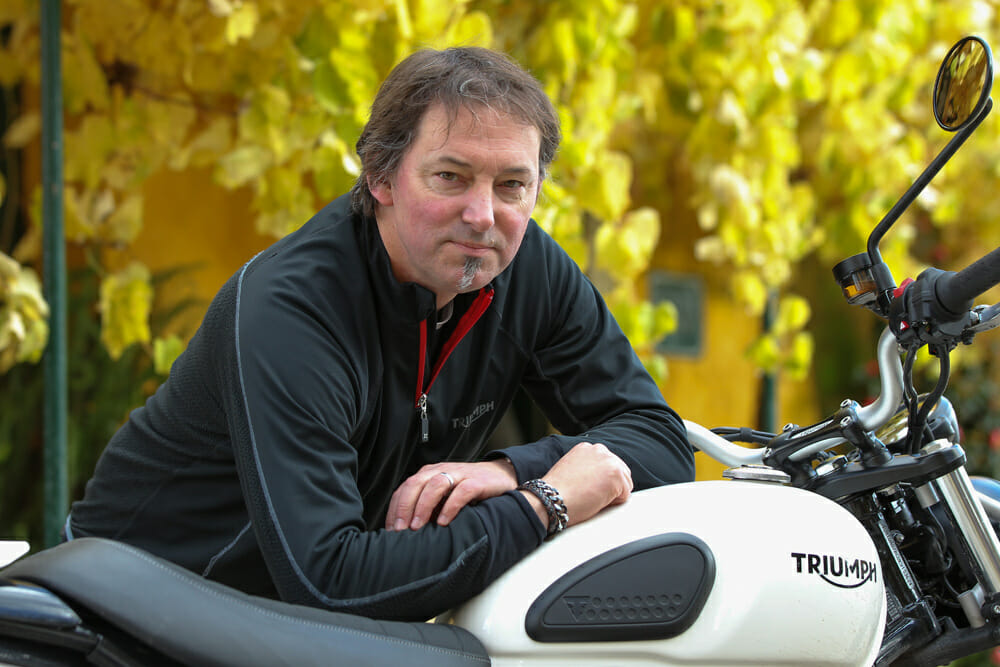 Stuart Wood is on a roll at the moment, helping Triumph produce some very fine motorcycles indeed.
Stuart Wood is on a roll at the moment, helping Triumph produce some very fine motorcycles indeed.
Despite the off-road-friendly 21-inch front wheel there was good feedback from the front Metzeler on tarmac, and especially on the slippery Portuguese roads we traversed during the morning rain when the ABS that was now switched on came into its own. Riding much harder that afternoon after the sun had come out to dry the roads revealed that besides looking cool the Scramblers are both excellent tarmac tools—they’re much more than just another ’60s inspired retro bike that’s all show and not much go. They’re as refined to ride as many sport bikes, with a level of equipment and technology that’s frankly surprising when you get to experience it if, as I’ll admit I did at first, you approach the bikes as being more style than substance. That’s very definitely not the case, and the applause from the Öhlins R&D team speaks volumes for the level of excellence off-road that Wood & Co. have attained with these two new models. Both the new Scramblers are serious off-road tools, making them genuine adventure bikes that just happen to have retro styling.
Looks like Triumph just succeeded in inventing an entire new segment in the motorcycle marketplace with these two models. Modern Classics, both of them.CN
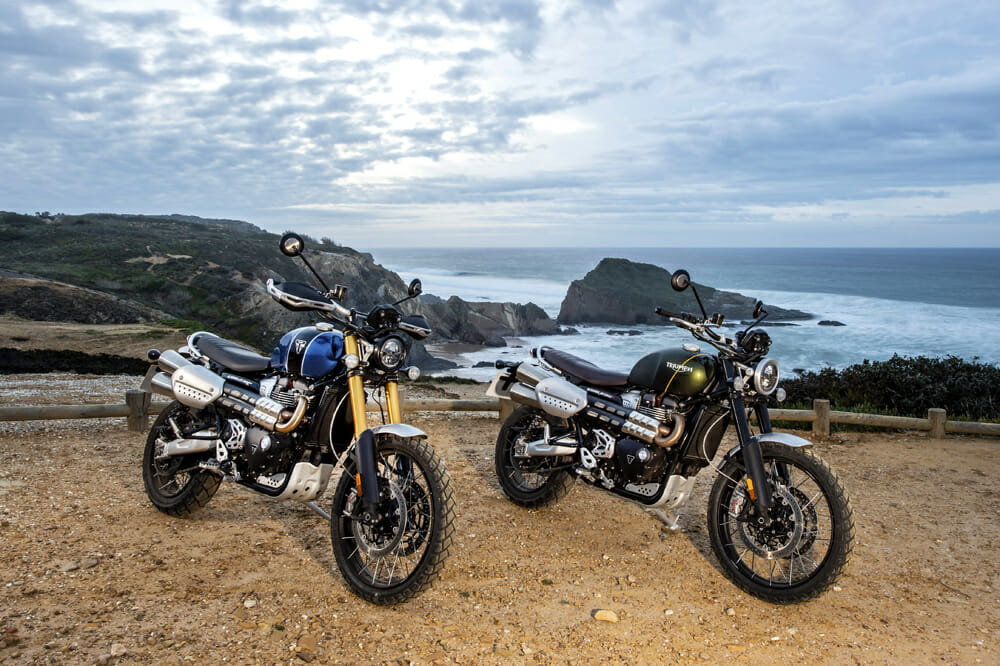
| SPECIFICATIONS |
2019 Triumph Scrambler 1200 XC / XE ($14,000 / XE $15,400) |
| Engine: |
Liquid-cooled, 8-valve, SOHC, 270° crank angle parallel twin |
| Displacement: |
1198cc |
| Bore x stroke: |
97.6 x 80mm |
| Compression ratio: |
11.0:1 |
| Fuel system: |
Multipoint sequential electronic fuel injection |
| Power: |
89 hp @ 7400 rpm (claimed) |
| Torque: |
81 lb-ft at 3950 rpm (claimed) |
| Exhaust: |
Brushed 2 into 2 with high-level silencers |
| Clutch: |
Wet multi-plate |
| Transmission: |
6-speed |
| Front suspension: |
Fully adjustable 45mm (XE 47mm) Showa inverted fork |
| Rear suspension: |
Fully adjustable Öhlins twin shocks |
| Front wheel travel: |
7.87 in. / 9.8 in. |
| Rear wheel travel: |
7.87 in. / 9.8 in. |
| Front brake: |
Twin 320mm discs, Brembo M50 4-piston monoblock calipers, radial master cylinder, switchable ABS XE / Cornering ABS |
| Rear brake: |
Single 255mm disc, Brembo 2-piston floating caliper, switchable ABS / XE Cornering ABS |
| Front tire: |
90/90-21 in. Metzeler Tourance / XE 90/90-21-in. Pirelli Scorpion Rally |
| Rear tire: |
150/70 R17-in. Metzeler Tourance / 150/70 R17-in. Pirelli Scorpion Rally |
| Wheelbase: |
60.2 in. / XE 61.8 in. |
| Seat height: |
33.0 in. / XE 34.2 in. |
| Fuel capacity: |
4.2 gal |
| Electronics: |
Five riding modes (Road, Rain, Off-Road, Sport, Custom) |
| Weight (claimed): |
451.9 lbs / XE 456.3 in. |